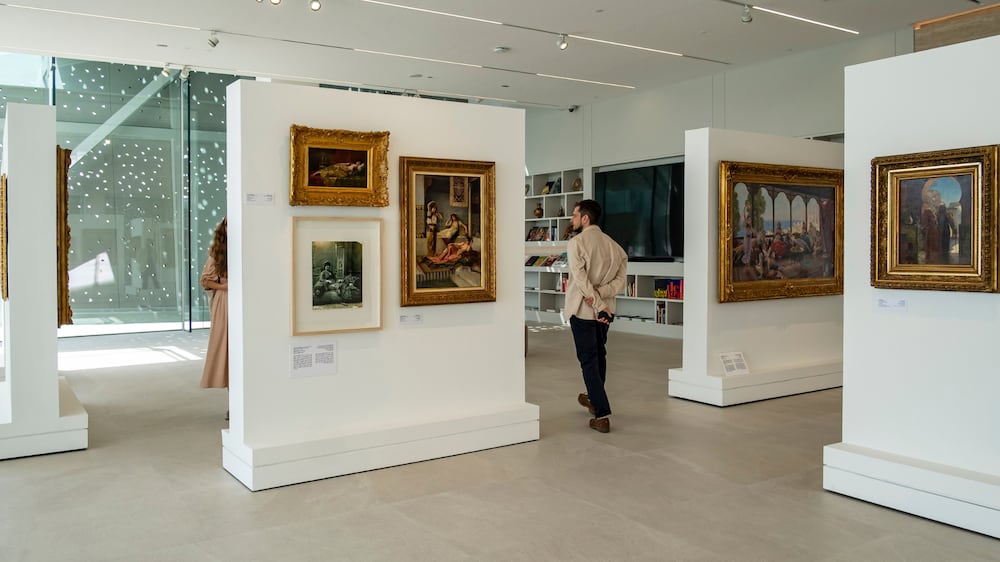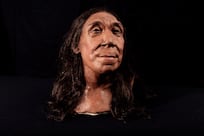In 1978, Edward Said published Orientalism. The book was seminal in challenging western perceptions of the Middle East, dismantling the fantastical construct that had contributed to colonial and imperial world views.
The orientalist’s Middle East was a “semi-mythical” place, Said pointed out. Exoticisms flourished in this fabrication, and they were most apparent in oil paintings between the 18th and 20th centuries. Women idled about in harems in sheer dresses and under the fog of shisha smoke, souqs bustled with impromptu music as belly dancers moved to the rhythm of tambourines, and there was little, if any, distinctions between how different countries in the region were depicted.
Architectural elements and arabesques were identical. The scenes featured in the paintings were decked with items that were arranged out of context. Balconies were draped with carpets. Tiger pelts were stretched over the floor alongside water jugs and copper lanterns. The objects were merely props as the artist considered aesthetic over function.
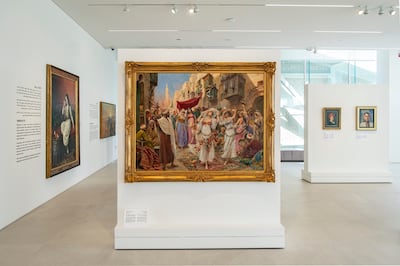
Said’s Orientalism was a marked chink in that fantasy. It showed how these stereotypes led to a perspective of the Middle East that was “lesser than” the West, in a way promoting notions that the area staggered behind the times, implying that it had to be conquered and brought to a more modern era.
His book paved the way for a more lucid outlook on the region. Of course, new and arguably more dangerous stereotypes emerged in the arts afterwards, particularly in film, but it was in paintings that these original exoticisations most apparently found form and propagated.
Echoes of the Orient, the inaugural exhibition of the Bassam Freiha Art Foundation, amply shows the makings of this construct, juxtaposing the paintings with 19th century photographs as well as artworks by modern Arab artists.
Seen with contemporary eyes and in the context of an exhibition set in the Arab world, the orientalist paintings seem naive in their depictions. They don’t incite scorn as much as they instil amusement. It is fascinating to see which elements of our region captured the imaginations of European painters in the 19th century. And to give credit where it’s due, technical proficiencies are evident in many of the artworks.
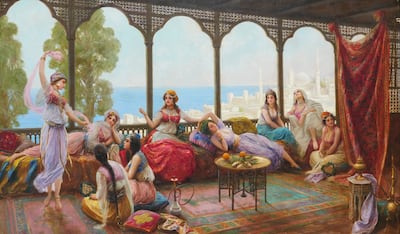
For instance, in Women Resting on the Terrace, an undated painting by Italian artist Fabio Fabbi, who lived between 1861 and 1946, a group of young women are gathered by a balcony overlooking a white city that is believed to be either Tangier or Algiers. Another painting by Fabbi, meanwhile, shows a marriage scene in Cairo, as a procession makes its way through the city. Mashrabiyyas jut out from the structures, dancers have taken to the streets and percussionists sit cross legged, playing tambourines to ignite celebrations.
The two scenes may have been propelled by the artist’s imagination, fed by his travels in the 1880s to Egypt, but they exhibit an impressionistic prowess nonetheless, with a vibrancy and palette that is arresting. The two paintings, like the majority of the works in the exhibition, come from the collection of Bassam Freiha himself.
“It was really important, of course, to showcase the collection of the founder,” Michaela Watrelot, head curator at the Bassam Freiha Art Foundation, says of the inaugural exhibition. “Mr Freiha is an avid collector of orientalism art. He has been collecting the pieces for more than 50 years.”
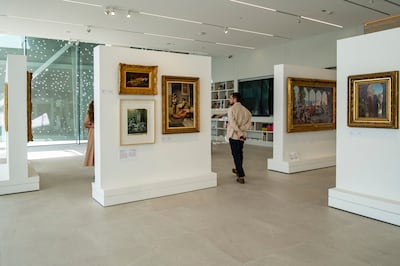
Echoes of the Orient presents works from Freiha’s trove of orientalist art alongside works from other private collections. The end result is a show that offers a multidimensional view of the relationship between orientalists and the Middle East, with gradients of fantasy contrasted with works grounded in realism.
“Orientalist art, of course, is the view from the West into the East,” Watrelot says. The exhibition, she points out, is structured into three sections. While one explores landscapes and architectural elements, the other two are dedicated to how women in the region were observed through the western lens. It looks at the perceived role of women in Middle Eastern society or, as Watrelot says, “how they were positioned within their social settings”.
“We have the explorations of motherhood,” she says. “We have beautiful, elaborate portraits and then, of course, the social gatherings, the courtyards and the harems.”
Orientalist art, she adds, is “often clouded by the fact that not every artist travelled to the region. A lot of them were getting inspiration through third sources like literature or photographs that were brought to their attention. It was a trend, of course, they were fascinated by everything coming from the Middle East.”
Even if artists did travel to the Middle East, such as Fabbi, they would never have had access to the harems so could not depict them with any ethnographic certainty. Not to say that was their concern to begin with. Rather, it was a combination of imagination and fantasy that artists drudged up their images from, aided by props that they arranged in their studios, around the models who posed for their paintings.
However, Echoes of the Orient is not merely interested in lambasting the orientalist movement. Rather, it aims to find a new way of looking at and interpreting the artworks. It seeks to explore what it was about the region that captured the attention and imagination of European painters.
“What was really important to the curation was to open up the dialogue between the West and the East and bring a more nuanced understanding of the movement and how we can reinterpret it today in our current context,” Watrelot says.
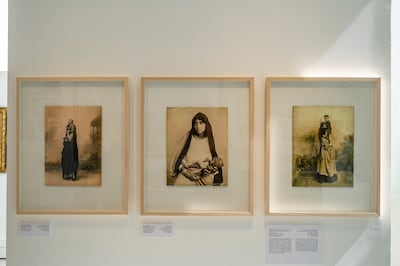
Orientalism, as the exhibition shows, is a spectrum. There are works that are much more outlandish in their depictions of the Middle East, whereas others seem to tread into the culture with a hint of sensitivity. The artworks by modern Arab artists, of course, are offered as an antidote, exhibited starkly against the works produced by 19th century European painters. However, it is the photographs that present the first bridge between fantasy and reality.
There are certainly photographs in the exhibition that have been composed with an exorbitant outlook, such as Studio Portrait of Harem Dancers in Port Said, an albumen print taken by the French photographer Hippolyte Arnoux. The work shows two dancers, dressed ornately and posing in a bemusing manner, leaning towards each other and holding a single tambourine over their heads. It is excessive in its composition, and the scene it conveys is so apparently suffused with fantasy that the photograph becomes almost delightful to look at. It's like a film that is so bad that it becomes good.
Still, there are photographs that are grounded in an ethnographic objective, and most of these are taken by artists who were from the region. These include the studio portraits of Gabriel Lekegian. Instead of hiring models to pose and perform for his works, the Egyptian-Armenian was instead interested in photographing people who he met from within the community.
“Some [photographers] were moving away from the orientalist tradition, like Lekegian, who was very much ethnographic in his approach. These are studio-staged photographs. But when you look at the depictions of motherhood, it's much more authentic. He is incorporating real people who he encountered in his photographs.”
The works may not be documentary-style photographs, Watrelot says, but were instrumental in “breaching the fantasy”.
Two of Lekegian’s photographs explore the theme of motherhood and feature women holding their young in their arms or on their shoulders. The women are dressed in a way that reflects actual traditions of the time.
The photographs are juxtaposed by a painting by 19th century Belgian artist Jan-Baptist Huysmans titled First Cradle in the East, which features a woman in a harem looking lovingly towards a cradle, where her child sleeps. The painting was produced in 1891, around the same time Lekegian took his photographs, but they could not be more wildly different, in style, focus and aesthetic, with Huysmans's maximalist touch making First Cradle in the East a quintessentially orientalist work.
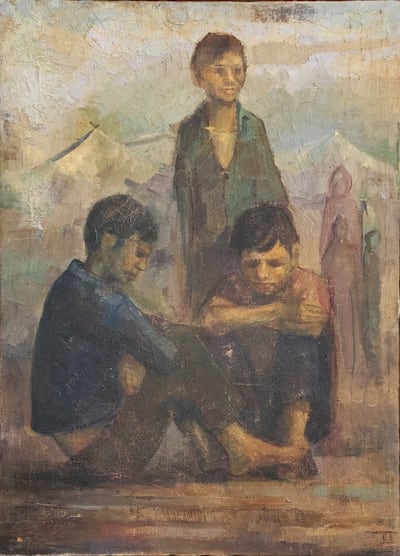
Displayed beside it is Abdul Qader Al Rais’s The Wait, a work that is a grim contrast to the orientalist flourishes of the former. The work was produced by the Emirati artist in 1968, just a year after the Naksa, when, in the aftermath of the 1967 war, Israel razed Palestinian villages, forcibly displacing thousands of people.
The work features three children, two of whom are seated on the ground with downcast gazes. Maternal figures are obscured in the background. Their presence as “silent sentinels” – as described in the painting’s caption, instils a feeling of protectiveness. However, concealed forms can also trigger ideas of absence, especially when considering the continuing tragedies in Gaza, where thousands of children have been killed and left orphaned.
The Wait, Watrelot says, “is one of our major pieces that we received on loan from the artist’s personal collection. It is really something that's very close to the artist’s heart. He said that he will never sell the piece.”
It was important to place the work in the section dedicated to motherhood as “it is not the romanticised version, but [rather] the maternal strength, the protective nature of the mothers who are standing as the abstracted figures in the background, overlooking their children, protecting them, taking care of them in times of upheaval, war, displacement [and] migration.”
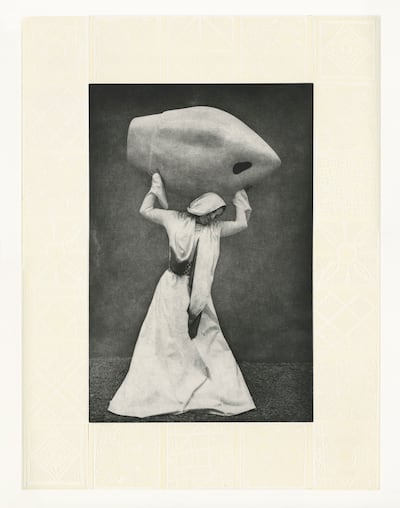
Other modern works by Arab artists within Echoes of the Orient that also serve as a potent antithesis to the stylised depictions of orientalists, include an untitled portrait by Lebanese painter Cesar Gemayel, which has been lent courtesy of Lebanese art expert Saleh Barakat. The work portrays a woman from Mount Lebanon with a direct gaze. It is contrasted with The Red Turban, a portrait by Belgian painter Leon Herbo that echoes orientalist traditions. A similar contrast is presented with a portrait by Lebanese painter Habib Srour, which depicts a Maronite Christian woman and is displayed opposite Oriental Beauty by Swedish painter Egron Lundgren.
These contrasts carry over to the landscape works, where embellished architecture stands opposite more subdued and realistic works. Between the real and the imagined, the fantastical and ethnographic, Echoes of the Orient provides a sweeping look at the Middle East between the 19th and 20th centuries. The show is then accentuated by Reclaiming Visions, an exhibition in the foundation’s annex gallery. The exhibitions feature photography from Sama Alshaibi’s Carry Over series, as well as sculptural works by Azza Al Qubaisi.
Displayed alongside 19th century portrait photography, the works critically examine representations of Arab women in the images before reclaiming the narrative. Alshaibi’s photographs make use of printing processes that 19th century photographers themselves employed. She touches upon motifs and props that the photographers used and exaggerates them in her self-portraits. However, there is a twist to how she presents these motifs.
“[Alshaibi] is taking an assertive role in reclaiming the narrative,” Watrelot says. “[She is] taking back the power of how Middle Eastern women have been represented. She's posing in the photographs herself. There are many layers of meaning. We have these enlarged sculpture vessels, like the water jugs we have seen repeatedly [in 19th century photographs] that she enlarges and places them on their heads. On one side, she purposefully chooses objects that represent the contributions of women to society, but then she makes them purposefully dysfunctional by including the large hole in a water jug, making it completely irrelevant, which plays into the narrative of continuous misrepresentation.”
Both Echoes of the Orient and Reclaiming Visions are running at the Bassam Freiha Art Foundation until August 15
